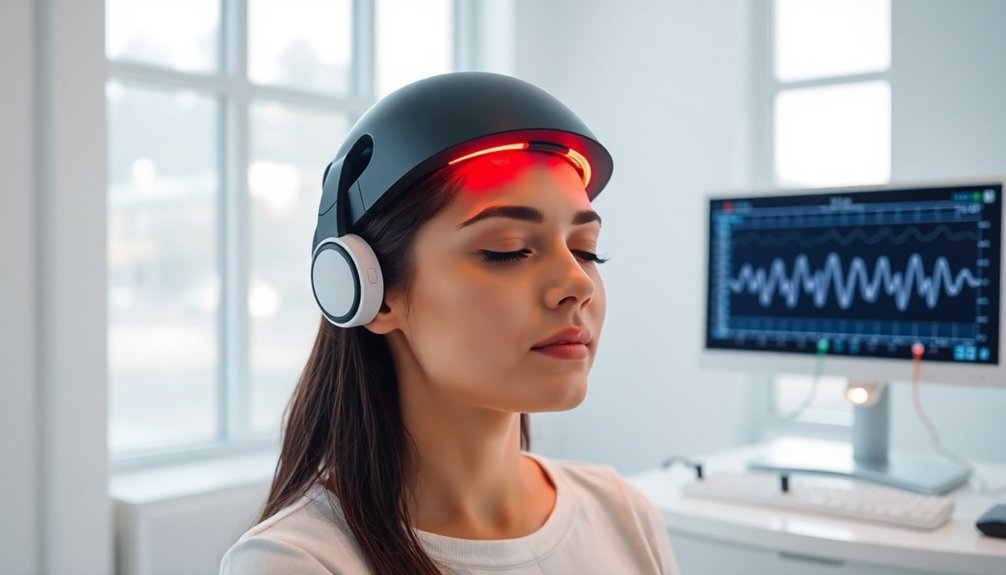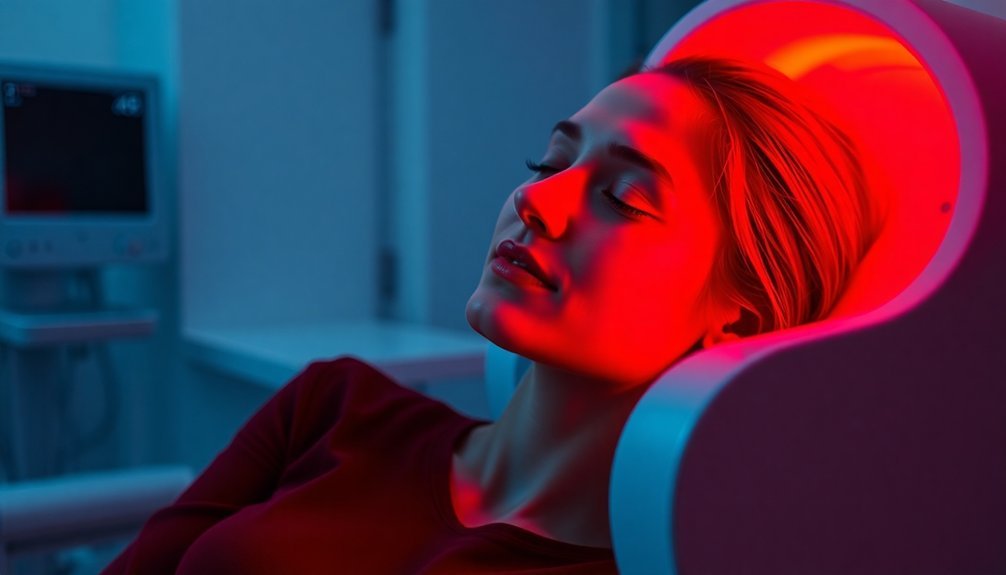Near-wavelength therapy can boost your brain's performance and focus through a process called photobiomodulation. When you receive this therapy, typically using 810nm or 1064nm wavelengths, it stimulates your brain cells' mitochondria to produce more energy (ATP) and increases blood flow through nitric oxide release. You'll experience improved attention, faster reaction times, and enhanced working memory as the light targets your prefrontal cortex. The therapy's non-invasive nature makes it a safe option for cognitive enhancement, with studies showing both immediate and long-lasting benefits. The science behind this breakthrough treatment reveals even more promising applications for brain health.
Understanding Near-Wavelength Brain Enhancement

Three key mechanisms drive near-wavelength brain enhancement: infrared laser stimulation, hemodynamic responses, and targeted brain region activation.
When you undergo transcranial infrared laser stimulation (TILS), it uses a specific 1064 nm wavelength to enhance your cognitive performance and boost cerebrovascular oxygenation. The therapy targets your right prefrontal cortex, a brain region essential for cognitive enhancement. The treatment requires participants and staff to wear protective eyewear during sessions for optimal safety.
Scientists measure these improvements through fNIRS technology, which tracks changes in your brain's oxygenated and deoxygenated hemoglobin levels during cognitive tasks. You'll notice enhanced performance in specific mental activities, particularly in psychomotor vigilance tasks and delayed match-to-sample tasks. This improvement isn't just subjective – it's measurable and reproducible in healthy young adults.
The therapy's effectiveness stems from its ability to stimulate mitochondrial activity, increase energy production, and reduce inflammation in your brain cells. As research continues to validate these mechanisms, you'll find that understanding how near-wavelength therapy affects your brain's hemodynamic responses is vital for its clinical applications.
This knowledge is paving the way for more targeted and effective cognitive enhancement treatments.
How Light Affects Neural Activity
Building on our understanding of near-wavelength stimulation, let's examine how light impacts your brain's neural circuits more broadly. When light enters your eyes, it triggers complex changes in your hypothalamus, with higher light levels boosting activity in regions that control wakefulness and alertness.
Higher illuminance levels can reduce activity significantly in anterior hypothalamic areas linked to sleep regulation.
You'll find that this activation pattern directly influences your cognitive performance, particularly in tasks requiring executive function and emotional processing.
Your brain's connectivity also responds substantially to light exposure. Research shows that light therapy can enhance neural connections, especially during recovery from brain injuries. These improvements typically emerge within the first two weeks of treatment, suggesting light's powerful influence on brain plasticity.
Light intensity particularly affects your mood regulation systems, with specific pathways in your cerebral cortex and prefrontal regions responding to different light levels.
However, you should note that disrupted light cycles can harm your brain's function, especially affecting areas like the dentate gyrus and medial amygdala. These disruptions can impair your memory and alter your behavior patterns, highlighting why maintaining proper light exposure is vital for peak brain performance and emotional well-being.
Cellular Energy and Mental Performance

Your brain's mitochondria work tirelessly to produce ATP, the cellular fuel that powers everything from basic neural firing to complex cognitive tasks.
When you're focusing intently on work or learning, your neurons require massive amounts of energy, with different brain regions competing for limited metabolic resources.
Studies show your brain consumes 20% of your body's total energy even during rest. You'll perform better mentally when your brain cells can efficiently generate and distribute energy, which is why maintaining healthy cellular metabolism is essential for sustained attention and cognitive function.
ATP Production Powers Thinking
Deep within every brain cell, ATP production serves as the fundamental power source for all cognitive functions. Your neurons rely heavily on this essential molecule, producing up to 20 times more ATP through mitochondrial processes compared to simple glycolysis.
When you're thinking, learning, or focusing, your brain's demanding energy needs are met through this essential ATP generation. Synaptic terminals produce energy locally to support rapid brain activity.
Your mental clarity directly depends on efficient ATP production, which requires specific proteins like MICU3 to regulate calcium uptake in mitochondria. This protein acts as a molecular switch, ensuring your brain's energy production closely matches its synaptic activity.
The NAD+/NADH ratio plays a key role too, acting as a critical cofactor in converting glucose to ATP.
When your ATP production decreases, you'll likely experience brain fog, difficulty concentrating, and reduced mental performance. This decline can happen due to aging, chronic stress, or various neurological conditions.
That's why maintaining healthy ATP levels is essential – it powers everything from neurotransmitter release to synaptic function. Without adequate ATP, your synapses can shut down, potentially contributing to cognitive decline and various neurological disorders.
Mitochondria Drive Brain Function
At the heart of brain function lies a complex network of cellular powerhouses – mitochondria. These tiny organelles are essential for every aspect of your brain's performance, from basic cellular processes to complex cognitive functions. They're responsible for producing ATP, the energy currency your neurons need to fire, communicate, and maintain their structure.
Your brain's mitochondria don't just generate energy – they're actively involved in neuroplasticity, helping your neural networks grow and adapt. They regulate calcium levels vital for neurotransmitter release and manage your brain's redox status through sophisticated quality control systems.
When you're thinking, learning, or focusing, your mitochondria are working overtime to meet these intense energy demands.
The health of your mitochondria directly impacts your cognitive performance. If they're not functioning at their best, you'll likely experience mental fatigue, decreased focus, and potentially more serious neurological issues.
That's why maintaining mitochondrial health is vital. Through processes like mitochondrial fission, fusion, and mitophagy, your brain constantly works to keep these powerhouses in top condition, ensuring you have the mental energy you need for peak cognitive performance.
Energy Flow Enhances Focus
Through the intricate dance of cellular energy production, ideal brain function depends on a constant, well-regulated flow of power. Your brain consumes about 20% of your body's oxygen and calories, using most of this energy to maintain neural signaling and restore ion balance after each nerve impulse.
When you're stressed, your cellular energy takes a hit, affecting both your mental performance and physical well-being.
Think of your brain cells like tiny power plants that need to maintain peak efficiency. Just as a car's performance depends on proper fuel consumption, your mental clarity relies on how well your cells manage their energy resources.
The key lies in maintaining the delicate balance between excitatory and inhibitory signals, which directly impacts your ability to focus and respond to stimuli.
- Your brain cells require constant energy to fire properly and maintain neural connections
- Stress can disrupt cellular energy production, leading to decreased mental performance
- The balance of excitatory and inhibitory activity determines your mental responsiveness
- About 80% of your brain's energy goes toward glutamate cycling and active signaling
Brain Blood Flow Benefits
Near-wavelength therapy offers remarkable benefits for brain blood flow, primarily through its ability to enhance cerebral circulation and oxygenation. When you expose your brain to specific wavelengths, particularly in the 808-830nm range, you'll experience increased blood flow that delivers essential oxygen and nutrients to your brain cells.
The therapy works through multiple mechanisms to boost your brain's circulation. It stimulates the release of nitric oxide, which helps dilate your blood vessels, while also increasing the expression of vascular endothelial growth factor (VEGF) that promotes the formation of new blood vessels.
You'll benefit from enhanced ATP production in your brain cells, as the light is absorbed by cytochrome C oxidase in your mitochondria.
These improvements in blood flow directly impact your brain's performance. You'll notice better mental clarity and reduced brain fog, as your brain receives superior oxygen and nutrient delivery.
The therapy's effects extend beyond immediate circulation benefits – it also promotes the release of brain-derived neurotrophic factor (BDNF), supporting neuroplasticity and long-term brain health.
Whether you're dealing with cognitive decline, mental fatigue, or seeking to enhance your brain function, enhanced blood flow through near-wavelength therapy can substantially improve your brain's performance.
Memory Enhancement Through Light

When you expose your brain to therapeutic wavelengths of light, you'll experience increased cerebral blood flow that can sharpen your focus and memory.
Your neural repair mechanisms kick into high gear as the light penetrates brain tissue, helping to restore and strengthen neural connections involved in memory formation.
The light therapy also boosts your mitochondria's energy production, giving your brain cells the power they need to maintain ideal memory function and cognitive performance.
Brain Blood Flow Boost
Light therapy's remarkable ability to boost brain blood flow stands at the forefront of cognitive enhancement research. When you expose your brain to specific wavelengths of light, particularly in the 633-1065nm range, you'll trigger a cascade of beneficial effects.
The therapy works by stimulating your brain cells to release nitric oxide, causing blood vessels to dilate and increasing oxygen delivery throughout your neural networks.
You'll experience enhanced cerebral blood flow through several key mechanisms:
- Your brain cells produce more ATP, giving you increased energy for better cognitive performance
- Your blood vessels expand through nitric oxide release, allowing for improved circulation
- Your body upregulates important growth factors like VEGF, promoting new blood vessel formation
- The therapy reduces MMP-2 activity, creating ideal conditions for blood vessel growth
This increased blood flow isn't just theoretical – it's measurable through SPECT scans and correlates with improved cognitive function. Whether you're dealing with traumatic brain injury, age-related cognitive decline, or simply want to optimize your brain performance, light therapy's ability to enhance cerebral blood flow offers a promising, non-invasive approach to better brain health.
Neural Repair Acceleration
Building on the brain's enhanced blood flow capabilities, neural repair and regeneration take center stage in the therapeutic potential of light-based treatments. You'll find that near-wavelength therapy accelerates your brain's natural healing mechanisms, particularly when applied during the critical acute-to-subacute recovery phase.
Research shows that low-power laser radiation specifically targets your peripheral nerves, speeding up axonal growth and regeneration. When you receive red light therapy, it boosts your cellular energy production while reducing inflammation, creating ideal conditions for nerve repair. The 780-nm wavelength has proven especially effective in enhancing axonal sprouting and myelinization.
You'll benefit from improved brain connectivity as light therapy enhances resting-state connections between pivotal brain regions. When combined with high-frequency rTMS, you can experience enhanced neural remodeling and better working memory performance, particularly beneficial if you're recovering from a stroke.
While scientists are still investigating the precise mechanisms behind these improvements, clinical trials consistently demonstrate significant functional recovery in patients with various types of nerve injuries. The therapy's anti-inflammatory effects play a key role in accelerating your neural repair process.
Mitochondrial Energy Production
Scientists have discovered that near-wavelength therapy directly supercharges your brain's cellular powerhouses – the mitochondria. When near-infrared light penetrates your brain tissue, it stimulates special light-sensitive proteins in your mitochondria, triggering increased ATP production and enhanced cellular energy transformation.
This boost in power enables your neurons to function more efficiently, leading to improved cognitive performance.
Your brain's mitochondrial health plays a vital role in everything from memory formation to stress management. When you're experiencing psychological stress or negative moods, your mitochondrial function actually decreases, impacting your ability to perform complex cognitive tasks.
However, near-wavelength therapy can help reverse this effect by:
- Increasing ATP production through enhanced oxidative phosphorylation
- Reducing harmful oxidative stress that damages brain cells
- Promoting mitochondrial repair through improved fission and fusion processes
- Stimulating neurogenesis in memory-related brain regions
The effects are particularly noticeable in attention, executive function, and working memory. Research shows that near-infrared LEDs and lasers are more effective than visible light therapy, making them powerful tools for maintaining ideal brain function and protecting against cognitive decline.
Protecting Brain Cell Health
Through a remarkable cascade of cellular interactions, near-infrared therapy safeguards and enhances brain cell health in multiple ways. You'll find that this therapy reduces inflammation by decreasing the activation of astrocytes and microglial cells while simultaneously lowering biochemical markers of cell death.
The therapy's protective effects extend beyond inflammation control. It stimulates new nerve cell growth and enhances brain connectivity, particularly in the critical first two weeks following injury. You'll benefit from improved cellular energy production as the treatment activates your mitochondria and enhances nitric oxide release.
| Brain Protection Mechanism | Key Benefits |
|---|---|
| Inflammation Reduction | Decreases astrocyte activation and cell death markers |
| Energy Enhancement | Boosts mitochondrial function and blood flow |
| Cell Regeneration | Promotes nerve cell growth and survival |
| Connectivity Support | Improves brain network connections post-injury |
| Wavelength Optimization | 810nm shows superior outcomes vs 660nm |
Research shows that pulsed frequencies, particularly at 40Hz and 100Hz, can deliver better cognitive outcomes than continuous waves. These findings have significant implications for treating various neurological conditions, including traumatic brain injury, Alzheimer's disease, and depression.
Athletic Mental Edge Applications

From high-stakes competitions to daily training sessions, near-wavelength therapy does not directly provide athletes with a mental edge that enhances focus and decision-making abilities. However, it can be combined with proven mental preparation techniques to achieve overall athletic excellence.
Near-wavelength therapy, specifically red and near-infrared light therapy, has been shown to enhance physical performance and recovery. Here's how it can be integrated with mental preparation techniques:
Physical Benefits of Near-Wavelength Therapy
Red and near-infrared light therapy penetrate deep into the skin, stimulating mitochondrial function and boosting cellular energy production. This therapy accelerates muscle adaptation, enhances recovery, and reduces inflammation.
- Accelerated Healing: Promotes faster cell regeneration, reducing the time needed for muscle repair and decreasing soreness.
- Reduced Inflammation and Pain: Alleviates pain and swelling by reducing inflammation.
- Improved Circulation: Enhances blood flow to the muscles, ensuring a better supply of oxygen and nutrients.
- Enhanced Muscle Performance: Boosts cellular energy production, leading to better endurance, strength, and overall performance.
Combining with Mental Preparation Techniques
While near-wavelength therapy primarily benefits physical recovery and performance, it can be part of a broader regimen that includes mental preparation techniques.
Visualization and Mental Imagery
Visualization is a cornerstone technique in sports psychology that enhances focus and optimizes performance through cognitive practice. Athletes use visualization to mentally simulate specific sports activities, reinforcing muscle memory and improving strategic anticipation.
- Pre-Competition Routines: Visualization helps prepare the mind for peak performance by anticipating and planning for the event.
- Daily Practice: Incorporating visualization into daily routines helps cement these skills as second nature.
- Integration with Physical Training: Visualization can be used during physical training sessions to enhance muscle memory and strategic thinking.
Mental Training Routine
- Daily Practice: Mental training should be a daily practice, not just a pre-competition ritual. Techniques like visualization, self-talk, or mindfulness should be allocated specific times in the daily schedule.
- Pre-Competition Routines: A structured mental routine before competitions prepares the mind for peak performance.
- Integration with Physical Training: Mental training techniques should be integrated with physical practice to enhance overall performance.
- Consistency and Progress Tracking: Consistency is key, and athletes should track their progress in mental training as they would with physical training.
Cognitive Strategies
Combining near-wavelength therapy with cognitive strategies can create a powerful framework for athletic excellence.
- Enhances Pre-Competition Visualization and Meditation Routines: While the therapy itself does not enhance visualization directly, the overall physical benefits can support better mental preparation.
- Strengthens Mental Resiliency During Intense Training Sessions: Better physical recovery can indirectly support mental resilience by reducing fatigue and improving overall well-being.
- Supports Cognitive Strategies for In-Game Performance Optimization: Improved physical condition can enhance cognitive functions during high-pressure situations.
- Amplifies Focus During Goal-Setting and Strategic Planning: Physical well-being can contribute to better mental focus and clarity during planning and strategy sessions.
Recovery and Cognitive Function
Recent breakthroughs in near-wavelength therapy reveal its powerful impact on cognitive recovery and brain function enhancement. Research shows that near-infrared light, particularly at 810nm wavelength, substantially reduces inflammation and promotes nerve cell survival when delivered directly to injured areas of the brain or spinal cord.
This therapy doesn't just protect cells – it actively enhances your cognitive performance. Studies demonstrate improvements in reaction time, attention, memory, and executive function. When combined with cognitive exercises, you'll experience better recovery outcomes, especially if you're dealing with traumatic brain injury or stroke recovery.
The therapy works by reducing cell death markers and stimulating new nerve cell growth.
If you're looking to maximize recovery, consistency is key. Regular practice of cognitive exercises alongside near-infrared light therapy helps rewire your brain through neuroplasticity. Within four weeks, you can expect notable improvements in balance and cognitive function.
While researchers continue developing specialized medical devices for this treatment, they're also exploring ideal parameters and combination therapies to enhance its effectiveness for various neurological conditions.
Scientific Evidence for Brain Benefits

Scientific studies have conclusively demonstrated the remarkable effects of near-infrared light therapy on brain function. Research shows that this therapy activates your brain's mitochondria, increasing cellular energy production while reducing inflammation in brain cells.
Clinical trials have confirmed that patients receiving near-infrared light therapy experience greater improvements in brain connectivity compared to control groups, particularly during the acute-to-subacute recovery phase.
The evidence for brain benefits is compelling, with research highlighting several key mechanisms that contribute to improved cognitive function:
- Your brain's blood flow increases through nitric oxide release, delivering more oxygen and nutrients to cells
- Cellular energy production gets a significant boost through mitochondrial activation
- Brain inflammation decreases, potentially reducing symptoms of neurodegenerative conditions
- Neural connectivity strengthens across multiple brain region pairs
While studies continue to explore long-term effects, current research validates the safety and efficacy of near-infrared light therapy for brain health. The therapy's ability to modulate brain repair processes makes it particularly promising for treating moderate traumatic brain injury and enhancing overall cognitive performance.
Treatment Duration and Protocols
Treatment duration and protocol requirements vary substantially based on your specific needs and the device you're using. For general brain performance enhancement, you'll want to start with 3-5 sessions per week, keeping each session between 1-10 minutes per targeted area.
Position your device 30-45 cm away from your head for peak results.
If you're addressing a specific brain injury or cognitive concern, you might benefit from more frequent sessions. Studies have shown promising results using 810-nanometer wavelengths, with even brief two-minute daily exposures producing positive effects.
You'll need to maintain consistency in your treatment schedule to achieve the best outcomes.
For ongoing maintenance, you can adjust your protocol as you monitor your response. Start conservatively and gradually increase duration if needed, but don't exceed 20 minutes per session.
You'll want to consult your device's manual for specific guidelines, as recommendations can vary between manufacturers. If you're dealing with a brain injury or specific neurological condition, it's crucial to work with a healthcare professional to determine the most appropriate treatment frequency and duration for your situation.
Long-Term Brain Health Results

You'll notice significant improvements in your cognitive performance that build over time with consistent near-wavelength therapy sessions.
The treatment's neuroprotective effects help shield your brain from damage while promoting the formation of new neural pathways, leading to enhanced memory, focus, and information processing.
Through regular sessions, you're strengthening your brain's resilience and plasticity, which creates a foundation for better long-term cognitive health and potentially reduces your risk of age-related neurological conditions.
Sustained Cognitive Performance Gains
Research into near-wavelength therapy has revealed promising long-term cognitive benefits that extend well beyond initial treatment sessions. Through consistent photobiomodulation treatments, you'll experience sustained improvements in key cognitive functions, including memory, attention, and mathematical processing abilities.
These gains aren't temporary – studies show that regular sessions can lead to lasting enhancements in brain performance and executive function.
Your brain's response to this therapy includes increased cerebral blood flow and enhanced oxygenation in the prefrontal cortex, creating conditions that support long-term cognitive improvement. The treatment triggers the release of beneficial compounds like brain-derived neurotrophic factor (BDNF) and nitric oxide, which contribute to sustained neural health and plasticity.
- Improved working memory and mathematical processing that persists after treatment
- Enhanced attention and learning capabilities that remain stable over time
- Sustained boost in prefrontal cortex activity and cerebral blood flow
- Long-lasting improvements in decision-making and emotional regulation
This therapy's cost-effectiveness and safety profile make it an attractive option for ongoing cognitive enhancement. As research continues, experts are discovering that combining PBM with other therapeutic approaches may maximize these sustained cognitive benefits, opening new possibilities for long-term brain health maintenance.
Neural Protection Over Time
While sustained cognitive gains are valuable, long-term brain health depends on thorough neural protection. Near-infrared light therapy offers promising neuroprotective benefits, particularly in the acute-to-subacute phases following brain injuries.
When you receive this treatment, the 850 nm wavelength penetrates your skull, triggering essential cellular mechanisms that support brain health.
You'll benefit from the therapy's ability to stimulate mitochondria, increasing ATP production and energy transfer within your brain cells. The treatment dilates blood vessels and reduces inflammation, creating an environment conducive to neural recovery.
While initial improvements are encouraging, you should note that long-term benefits still require more research to confirm their permanence.
You can complement light therapy with high-intensity interval training (HIIT), which has shown lasting cognitive benefits, particularly in hippocampal-dependent learning.
If you're recovering from conditions like COVID-19, which can impact brain volume and cognitive function, near-infrared therapy's non-invasive nature makes it an accessible treatment option. The portability of light therapy helmets means you can receive treatment outside hospital settings, making it a practical choice for ongoing neural protection.
Cumulative Neuroplasticity Benefits
Brain-boosting benefits of near-wavelength therapy accumulate over time, leading to lasting improvements in neuroplasticity and cognitive function. As you continue regular sessions, your brain's ability to form new neural connections strengthens, while cellular processes become more efficient.
The therapy enhances your brain's oxygen utilization and ATP production, creating ideal conditions for cognitive enhancement and neural repair.
When you combine near-wavelength therapy with aerobic exercise, you'll maximize neuroplasticity benefits through increased BDNF production and improved blood flow. The therapy's interaction with cytochrome C enhances your brain's energy production, supporting everything from memory formation to attention span.
- Your cognitive function improves as new synapses form and neurons maintain better survival rates
- Your concentration and attention span enhance through increased cellular activity and neurotrophic factors
- Your brain's recovery capabilities strengthen, supporting rehabilitation from injuries or cognitive decline
- Your memory retention and learning capacity expand due to enhanced neural connections
Research consistently shows that these improvements continue even after treatment ends, suggesting that near-wavelength therapy triggers lasting positive changes in brain function and structure. The therapy's cumulative effects make it particularly valuable for long-term cognitive health maintenance.
Frequently Asked Questions
Can Near-Infrared Therapy Help With Seasonal Affective Disorder (Sad)?
Yes, near-infrared therapy can help with your SAD symptoms by penetrating your brain tissue, boosting cell energy, and improving blood flow. You'll find it's particularly effective when combined with traditional light therapy.
Are There Any Age Restrictions for Using Near-Infrared Light Therapy?
While there aren't universal age restrictions for near-infrared light therapy, you should consult your healthcare provider before starting, especially if you're elderly, have skin conditions, or take photosensitive medications. Always use eye protection.
How Does Near-Infrared Therapy Interact With Common Medications?
You'll need to be cautious as some medications like lithium, antibiotics, and melatonin can increase photosensitivity. You should always check with your doctor and stop certain medications before starting near-infrared therapy.
Can Pregnant Women Safely Undergo Near-Infrared Light Therapy?
You can safely use near-infrared therapy while pregnant, but you'll need your OBGYN's approval first. Don't apply treatment to your belly or lower back, and always wear protective eyewear during sessions.
Does Skin Pigmentation Affect the Effectiveness of Near-Infrared Light Therapy?
Your skin pigmentation has minimal impact on near-infrared light therapy's effectiveness. The wavelengths can penetrate deeply regardless of melanin levels, though you may need slight adjustments in treatment parameters for best results.
In Summary
You'll find near-wavelength therapy offers a promising path to enhanced cognitive performance and brain health. Through targeted light exposure, you're able to boost cellular energy, increase blood flow, and improve memory function. When you follow proper treatment protocols, you can experience noticeable improvements in focus and mental clarity. The scientific evidence backs these benefits, making this therapy worth considering for your long-term cognitive wellness.





Leave a Reply